
SCULPTURAL CONTENT OF IGBO LAJA
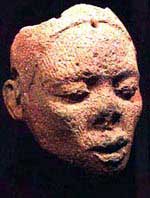 |
|
1 - Lagos,
National museum. |
Excavation revealed a number of concentrations of cultural artifacts. However, one concentration only contained almost all the terracotta sculptures in human and animal forms. The situation in which they were found suggests that they might have once stood on an altar, possibly inside a mud hut which was eventually destroyed. Some of the sculptures display features which are characteristic of Ife art while others resemble Benin art in form and concept. Yet a third category, designated Owo style, for the sake of convenience, is different from both Ife and Benin styles.
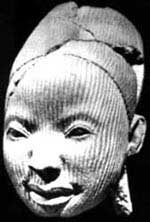 |
|
2 - Lagos,
National museum. |
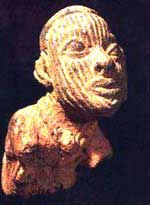 |
| 3 - Lagos, National museum. Terracotta |
All the sculptures were found on one level without any trace of superposition. However, one important feature must be mentioned. It was found that a pit had been dug into the main concentration, in which were buried two unrelated fragments of terracotta sculptures. As the radiocarbon date from the main concentration is earlier than the one from the pit, it is inferred that the pit was dug into the concentration at a later date and at a time when the making of terracotta sculptures had died out. The pit was used for hiding away the pieces when not in use; the charred wood marked the spot where they would be found when required. This re-use of sculptures in Owo is supported by the fact that one terracotta head found at the site which had signs that it had previously been eroded out, has a hole which is still comparatively fresh. What it was re-used for was suggested from a similar head, also heavily eroded (Fig. 1), which also has a hole with comparatively fresh marks and was used by the present Alaja as a pectoral pendant. This re-use of sculptures as indicated by the pit fragments provides evidence for the upper time limit for the making of these terracotta sculptures in Owo, just as similar evidence from Ife fixed the upper time limit there.
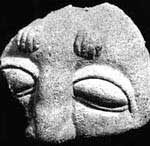 |
|
4 - Lagos,
National museum. |
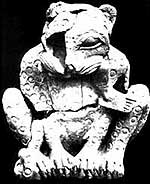 |
| 5 - Lagos, National museum. Seated leopard Terracotta |
Fig. 2 and Fig. 3 illustrate the affinities
between Ife and Owo sculptures, while Fig. 3 is in the Benin style. A Benin concept adopted in Owo is demonstrated by the
powerful representation of leopards e.g. Fig. 4 for, although leopards are sometimes represented in Yoruba art,
the eminence given to them in Owo art seems to owe something to the association
between the king and the animal in the culture of Benin.
For the sake of convenience, those objects whose style conforms to neither the
Ife nor the Benin style are regarded as Owo style, for example Fig. 5.
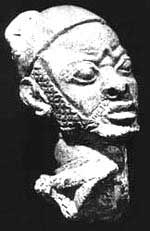 |
|
6 - Lagos,
National museum. |
Ricerca Ing. F.P. Di Giacomo - Dati e cartografia in internet: Alpha Consult S.r.l - Web: G. Cerica |
|||